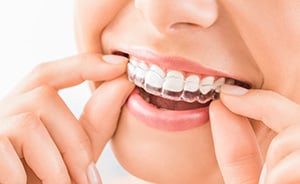Invisalign®
What Is Invisalign?
 Invisalign is a clear braces system that utilizes a series of plastic aligners to gradually shift misaligned teeth into a straightened position. Many of our patients at Roberts Dental Group choose Invisalign as a more discreet method of achieving straight teeth, compared to traditional braces which tend to have bold metal wires and brackets. Instead of going to a specialist, our patients have the option of working with our cosmetic dentist, Dr. Justin Roberts, for their Invisalign care. Dr. Roberts is highly experienced in the full breadth of general, restorative, and cosmetic dentistry solutions.
Invisalign is a clear braces system that utilizes a series of plastic aligners to gradually shift misaligned teeth into a straightened position. Many of our patients at Roberts Dental Group choose Invisalign as a more discreet method of achieving straight teeth, compared to traditional braces which tend to have bold metal wires and brackets. Instead of going to a specialist, our patients have the option of working with our cosmetic dentist, Dr. Justin Roberts, for their Invisalign care. Dr. Roberts is highly experienced in the full breadth of general, restorative, and cosmetic dentistry solutions.
- Invisalign Benefits
- Invisalign Candidates
- How Invisalign Works
- Invisalign Treatment Time
- Invisalign Process
- Invisalign Care
- Invisalign vs. Braces
- Invisalign Alternatives
- Invisalign Cost
- Additional Invisalign FAQs
What Are the Benefits of Invisalign?
Invisalign offers a modern approach to straightening teeth through custom-made and clear aligners. Key benefits of the orthodontic treatment include:
- Aesthetics: These virtually invisible aligners are discreet, making them a popular choice for patients who prefer not to have metal braces.
- Comfort: With smooth plastic construction, Invisalign aligners are typically more comfortable and less likely to irritate your gums and cheeks.
- Convenience: These aligners are removable, allowing for easier eating, brushing, and flossing, as well as promoting better oral hygiene during treatment.
- Predictability: Advanced 3D imaging technology allows you to preview the final results before starting treatment for a clear picture of your anticipated outcome.
- Efficiency: For many patients, Invisalign treatment typically requires fewer dental office visits.
Who Is a Candidate for Invisalign?
 Invisalign is often ideal for teens and adults seeking a less visible alternative to traditional braces. Treatment can address various dental issues, including crowded teeth, gaps, overbites, underbites, and crossbites. Candidates should have good oral health with no untreated cavities or gum disease. Commitment to wearing the aligners for the recommended 20-22 hours daily is crucial for successful treatment.
Invisalign is often ideal for teens and adults seeking a less visible alternative to traditional braces. Treatment can address various dental issues, including crowded teeth, gaps, overbites, underbites, and crossbites. Candidates should have good oral health with no untreated cavities or gum disease. Commitment to wearing the aligners for the recommended 20-22 hours daily is crucial for successful treatment.
Invisalign may not be suitable for severe orthodontic cases or for individuals who require complex tooth movements, for which traditional braces might be more effective. A consultation can help determine if Invisalign is the right choice based on your individual dental needs.
How Does Invisalign Work?
 If you are deemed a good candidate for Invisalign, Dr. Roberts can begin the planning process for your treatment. Impressions will be taken of your teeth, which allow for the creation of your custom aligners. Once these are ready, you will need to wear your Invisalign trays for at least 20 to 22 hours every day. Dr. Roberts recommends only removing your aligners when eating, cleaning them, or brushing and flossing.
If you are deemed a good candidate for Invisalign, Dr. Roberts can begin the planning process for your treatment. Impressions will be taken of your teeth, which allow for the creation of your custom aligners. Once these are ready, you will need to wear your Invisalign trays for at least 20 to 22 hours every day. Dr. Roberts recommends only removing your aligners when eating, cleaning them, or brushing and flossing.
You will need to return for periodic dental appointments so Dr. Roberts can monitor your progress. At each visit you will be provided with multiple sets of Invisalign aligners, each of which will be worn for about a week. As you progress to each new set of aligners, they will gradually be straightening your teeth.
How Long Does Invisalign Take?
On average, Invisalign typically takes 12 to 18 months to complete, but this may vary depending on the complexity of each patient’s case. If you do not wear your aligners for the instructed amount of time, this can prolong the duration of your treatment. Dr. Roberts can provide you with a more personalized timeline for your Invisalign treatment, based on the details of your orthodontic plan.
Does Invisalign Hurt?
Invisalign is a relatively comfortable and seamless treatment for patients who want to correct misalignment within their smile and bite. For patients new to Invisalign, there will be an initial adjustment period as you become acclimated to your aligners. Patients are often instructed to practice speaking with their aligners to become more comfortable with wearing them. While Invisalign may cause minimal discomfort at the beginning of the process, most dentists and patients agree that aligners cause significantly less irritation than metal braces.
How Do I Clean My Invisalign Aligners?
The required care for Invisalign aligners will typically mirror traditional teeth cleaning and oral hygiene practices, with some minor differences. If you wish, Invisalign aligners may be set in a special solution that is designed to maintain and clean them when they are not in use. Dr. Roberts can give you more information about a cleaning solution during your appointment. Alternatively, patients can simply rinse their aligners in lukewarm water and gently brush them with a mild soap.
When cleaning your aligners, do not use excessive or extremely hot water, as it can warp the device. Brushing and flossing your teeth will be vital in maintaining the overall care of your smile and aligners. You should avoid eating with your aligners altogether, but brushing your teeth after consuming soda, coffee, tea, drinks with red food coloring, and foods high in acidic content in particular, can help prevent staining. Ensuring there are no food particles left behind before wearing your aligners can prevent food from becoming wedged between your teeth and the appliance. Additionally, you should wear aligners as instructed and keep up with scheduled appointments to stay on track with your treatment plan.
Invisalign vs. Braces
Invisalign is typically considered a revolutionary step in dentistry when compared to traditional braces. Invisalign can achieve results that are equal to (or better than) the outcomes of traditional braces, while the treatment process is often completed more comfortably and in a shorter time frame. If you are looking to address misaligned teeth and bite irregularities, but want to avoid a system that uses metal brackets and wires to accomplish your goals, Invisalign may be the ideal solution for you. With clear plastic aligners, Invisalign can significantly reduce the discomfort that is often associated with braces. The aligners can be extremely discreet while producing very efficient results. Invisalign can also help cut down the amount of dental appointments and overall maintenance required.
Are There Alternatives to Invisalign?
There are several alternatives to Invisalign for those considering orthodontic or cosmetic dental treatments. Traditional metal braces can be highly effective for a wide range of dental issues and are well-known for their reliability. Lingual braces, another option, attach to the back of the teeth and remain completely out of sight. Additionally, porcelain veneers can provide a cosmetic solution that corrects the appearance of gaps, chips, or minor misalignment without altering the teeth’s natural structure as extensively as braces. Consulting with a dental professional is essential to determine the most appropriate option for your specific dental needs and smile goals.
How Much Does Invisalign Cost?
Invisalign tends to cost between $3,000 and $5,000, but this will be different for each patient. A number of factors will influence your Invisalign price, including the severity of your crowding and misalignment, your dentist, and the geographic location of the practice. You will be provided with an accurate quote before treatment to help you budget for your care.
We also offer financing options for qualified applicants to help manage the cost of Invisalign treatment.
Additional Invisalign Frequently Asked Questions
How old do I have to be to undergo Invisalign treatment?
Invisalign is suitable for teens and adults, but teens can specifically benefit from treatment that accommodates their developing mouths. Teens can start using Invisalign Teen once most of their permanent teeth have come in and their jaw growth is near completion, typically around the ages of 12 to 14. There is no upper age limit for adults seeking Invisalign treatment.
What can I eat and drink with Invisalign?
With Invisalign, there are typically less food and drink restrictions since the aligners are removable. However, it is important to remove the aligners before eating or drinking anything other than water to prevent staining and damage. After consuming foods or beverages, especially those that are sugary or acidic, it is recommended that you brush your teeth before reinserting the aligners to maintain good oral hygiene and prevent issues like cavities or gum disease.
Is Invisalign covered by insurance?
Invisalign may be partially covered by dental insurance if your plan includes orthodontic benefits. The amount of coverage can vary depending on the specifics of your insurance policy. Many plans that cover traditional braces may also cover Invisalign to a similar extent. We recommend consulting with your insurance provider to understand the details of your coverage, including any deductibles or annual limits.
For more information about Invisalign treatment or to schedule a consultation with Dr. Roberts, please contact our office today.